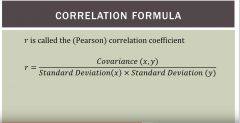![]()
![]()
![]()
Use LEFT and RIGHT arrow keys to navigate between flashcards;
Use UP and DOWN arrow keys to flip the card;
H to show hint;
A reads text to speech;
11 Cards in this Set
- Front
- Back
|
Bivariate relationships |
The relationship between two variables |
|
|
covariance |
Provides the direction of the linear relationship between two variables. Has no upper or lower boundary. The scale of the covariance depends on the variables. |
|
|
covariance and linear relationships. |
Covariance is one of a family of statistical measures used to analyze the relationship between two variables. Positive = increasing linear relationship Negative = decreasing linear relationship |
|
|
Correlation |
Provides the direction of the linear relationship between two variables. and the strength of the relationship. Its scale is independent of the variables themselves. From -1 to 1. |
|
|
Linear Regression |
Related to the covariance and the correlation. |
|
|
Covariance, Correlation, Linear Regression |
Are all tools to analyze how to variables behave together. |
|
|
Steps to calculating correlation. #1? |
Look at the scatter plot. |
|
|
Steps to calculating correlation #2? |
Correlation is only applicable to linear relationships. |
|
|
Correlation is not causation. |
Spurios correlation: when two completely unrelated factors may have a mathematical correlation but have no sensible correlation in real life. |
|
|
Correlation Formula |

1. Covariance between the two products. 2.Divided by the product of their standard deviation. |
|
|
Covariance Formula |
**INSERT HERE** |

